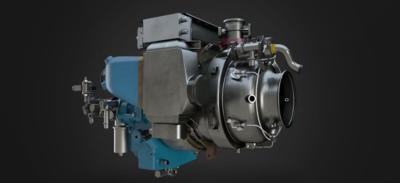Love for the Little Engines that Can
Honeywell Aerospace, the storied North Carolina-headquartered aero-engine and avionics marque, unveiled a new High-Efficiency Mode (HEM) upgrade for its 131-9B Auxiliary Power Unit (APU) for Boeing 737 aircraft.

The high efficiency connoted by the APU upgrade’s appellation derives in part of an innovative and efficient software-controlled diffuser that autonomously regulates airflow to the APU compressor section. The HEM upgrade is expected to provide fuel savings, increased efficiency, and diminished APU CO2 emissions on the order of one-to-two-percent (estimated reduction of 0.5 to 0.6 gallons per APU operational hour) and increase time-on-wing by up to 1,500 APU flight hours—thereby significantly lowering fuel and maintenance costs.
An Auxiliary Power Unit (APU) is a small gas-turbine engine crammed into an aircraft’s innards—usually behind its aft-pressure bulkhead—for purpose of powering subject aircraft’s electrical and environmental systems prior to main-engine start and after main-engine shut-down. Passengers boarding airliners in summer’s heat and winter’s cold are respectively cooled and warmed by virtue of a functioning APU. Moreover, SICs relegated to menial labor the likes of gleaning ATIS information, copying IFR clearances, and uploading flight-routes, vertical navigation profiles, fuel, and weight-and-balance data into Flight Management Systems (FMS) do so by via avionics suites powered by APUs.
Among the APUs numerous indispensable functions is providing electrical power by which to start aircraft main-engines. The amount of juice required to turn the cores of large turbine engines is considerable and quickly exhausts aircraft batteries. What’s more, low-energy main-engine starts, such as those rendered probably by partially-depleted ship’s batteries, are apt to occasion hot-starts—the bane of turbine pilots’ lives and the subject of innumerable ground-school lectures delivered by bored chief pilots and ass-chewings handed out angry directors of maintenance.
As APUs go, Honeywell’s 131-9B is known for its reliability and low maintenance costs.
Honeywell Aerospace Americas president of aftermarket Heath Patrick stated: “Globally, airlines are working to reduce their carbon footprint and every incremental step will help them in achieving their net-zero carbon emissions targets. An airline with a fleet of fifty 737s could realize as much as $450,000 in annual fuel savings and reduce their emissions by up to 1,100 metric-tons of CO2, depending on operating conditions. Also, increased time-on-wing can reduce maintenance cost by decreasing the number of servicing events needed, providing average savings of $315,000 for each avoided service visit.”

The HEM upgrade is intended for aircraft already operating Honeywell 131-9B APUs, including Boeing 737-600, 737-700, 737-800, 737-900 and 737 MAX models. The upgrade will be available in the second half of 2023, can be installed during any regularly-scheduled maintenance event, and does not require additional downtime for newer 131-9B APUs (series 49 and above) delivered from their OEMs with the new diffuser.
The HEM upgrade was previously introduced on the Airbus A320 series aircraft in 2020 and is now installed on over seven-hundred in-service 131-9A APUs.
Honeywell has designed and built upwards of one-hundred-thousand APUs since the company’s first Auxiliary Power Unit took to the skies in 1950. Currently, north of 36,000 Honeywell APUs are in global service aboard the fixed and rotary-wing aircraft of more than 150 regional, executive, commercial, and military users.
 ANN's Daily Aero-Term (12.19.25): Ultrahigh Frequency (UHF)
ANN's Daily Aero-Term (12.19.25): Ultrahigh Frequency (UHF) NTSB Prelim: Cirrus Design Corp SR22T
NTSB Prelim: Cirrus Design Corp SR22T Classic Aero-TV: The Red Tail Project--Carrying the Torch of the Tuskegee Airmen
Classic Aero-TV: The Red Tail Project--Carrying the Torch of the Tuskegee Airmen Aero-News: Quote of the Day (12.19.25)
Aero-News: Quote of the Day (12.19.25) Airborne 12.17.25: Skydiver Hooks Tail, Cooper Rotax Mount, NTSB v NDAA
Airborne 12.17.25: Skydiver Hooks Tail, Cooper Rotax Mount, NTSB v NDAA




